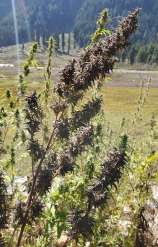Red Kumrat
breed by Indian Landrace Exchange
Here you can find all info about Red Kumrat from Indian Landrace Exchange. If you are searching for information about Red Kumrat from Indian Landrace Exchange, check out our Basic Infos or Lineage / Genealogy for this cannabis variety here at this page and follow the links to get even more information. If you have any personal experiences with growing or consuming this cannabis variety, please use the upload links to add them to the database!
Basic / Breeders Info
Red Kumrat is a sativa variety from I.L.E. and can be cultivated indoors (where the plants will need a flowering time of ±60 days), outdoors and in the greenhouse. I.L.E.s Red Kumrat is a THC dominant variety and is/was never available as feminized seeds.
I.L.E.s Red Kumrat Description

 Red Selection from the Kumrat Valley, Khyber Pakhtunkhwa, featured a tall/wispy structure up to 7ft tall with minimal side branching. The flowers were quite airy and lose covered in resin and many bracts already opening up to disperse the seeds. It carried a strong piney stench, along with aromas resembling industrial adhesive.
Red Selection from the Kumrat Valley, Khyber Pakhtunkhwa, featured a tall/wispy structure up to 7ft tall with minimal side branching. The flowers were quite airy and lose covered in resin and many bracts already opening up to disperse the seeds. It carried a strong piney stench, along with aromas resembling industrial adhesive.
A truly beautiful example of a primordial landrace variety, which hasn’t been systematically cultivated or domesticated, by human beings but only used as a herb procured directly from the wild. Hence, these populations have been surviving completely on their own in this harsh terroir for the longest time by letting the environment take complete control of their evolutionary path. Where, the environmental pressure of the terroir gradually shapes the plant populations overtime to best fit their ecological habitats, imperative for long term survival.
Kumrat Valley, is located towards the northernmost fringes of the Khyber Pakhtunkhwa around 35N, with an average floor elevation of 2000 meters. The Valley lies in the lesser known kohistan region which is inhabited by mostly Kohistani tribes.
Due to a combination of high latitude position and high altitude the onset of snow comes as early as late October to early November, which brings the valley to a halt until April when the snow clears.
Kumrat Valley is located towards the south East of Chitral and hence falls around the eastern foothills of the Hindu Kush mountain range traversing into Afghanistan.
Kumrat Valley, doesn’t have any planned cultivation of cannabis at all, and all the cannabis populations in the valley are intact in their primordial form, completely unaffected from any domestication efforts.
The local variety grows up to be an extremely thin, wispy up to 5-7 ft tall plants, with disperse bract flower structure. The seeds are ejected from the bracts automatically at different times during the flowering period similar to other wild varieties we have seen in the past. However, the size and the density of the resin glands is exceptional as expected from a cannabis population adapted to
an extremely cold (semi-tundra) climate.
These primordial landrace populations represents the actual Hindu Kush highland variety which has been taken by farmers, travellers, collectors and so many others to a variety of different habitats from it’s own. To be then domesticated, bred, selected and turned into something more productive to human beings.
The overall lack of vigor in the plants, can be seen from a lesser root mass to thin/wispy stems only capable of producing
little bud growth.The buds typically feature smaller sized bracts with a short life span, facilitating the self dispersal of the
seeds. In the valley, seeds fall on the ground each year to be buried under the snow for at least 4 months before they can sprout up once again in the spring season.
The seeds are typically oblong/pear shaped, tiny and dark in color. The seeds have extremely hard shells, that seems to have developed multiple non permeable layers, which stops the moisture from entering the seed for long periods of time thus delaying
the germination until the favourable time of the year, i. e. spring.
The weather around the harvest window gets extremely cold, with a wild swing in the day and night time temperatures.
A lot of plants can be seen expressing vibrant hues of purples and reds.
The flowering window is only around 8-9 weeks in the valley, which begins from August and closes in the first week of
october as the snow comes in. These plants appear similar to the primordial Landrace populations documented in
northern Kashmir (Lolab valley) and even from the southern Kashmir region like Srinagar and Pulwama.
Which finishes with an appearance similar to a long flowering variety from lower latitudes, However, the flowering term is
significantly shorter (almost half compared to Landraces adapted to temperate regions located at lower latitudes)
The buds are much more dense and the resin production is exceedingly better with bigger size of resin glands , especially the
capitate-stalked trichomes which are rarely seen on the landrace varieties from hotter (temperate and equatorial) regions.
Type: FIRST GENERATION (P1) LANDRACE STRAIN
Format:Regular
Sativa / Indica ratio: 100 % sativa
Flowering indoors: 8-9 weeks
Flowering outdoors: Early October
Yield: Average-Low
Resistance against spider mites: High
Resistance against powder mildew: High
Resistance against botrytis: High
Resistance against white fly: Average-High
Resistance against cold: High
Resistance against heat: High
Latitude: 0º-50º
Genetics:
Best red selection from wild plants found in Kumrat Valley during 2021 season. First generation pure sativa landrace from Northern Pakistan.
Structure:
Tall, wispy structure up to 7ft tall with minimal side branching.
Bouquet:
Strong piney stench, along with aromas resembling industrial adhesive.
High:
A wilder population with not so strong but very unique, uplifting and mood elevating effects.
Terpene profile:
It has not yet been analyzed.
Growing Tips:
Especially recommended for outdoor growing in cold and dry climates due to its excellent adaptability to cold temps and drought in its place of origin. It withstands without problem the cold during flowering and strong temperature variations throughout its development. It can easily be grown indoors too.
We recommend soft-moderate levels of nutrients for the whole cycle.
Red Kumrat Lineage / Genealogy
- Red Kumrat »»» Pakistan Sativa
- Pakistan Sativa »»» Sativa
Map of the Red Kumrat Family Tree
Click to show all parents of Red Kumrat in our dynamic family tree map.
Upload your info about this strain here:
Do you know something more about I.L.E.s Red Kumrat? Please help to make this database better and upload/connect your information here!
Pictures
Pictures speak louder than words! Upload your "Red Kumrat" Photos here and help other growers to get a better impression of this variety.
Comparisons
You have grown Red Kumrat together with another variety? Please fill out our Strain VS. Strain direct comparisation form!
User Reviews
Our strain reviews are multilingual, searchable and can be very detailed - including data about the grow, aroma, effects and taste! Please upload your Red Kumrat Review here to help the other seedfinder users!
Medical Values
You have experience with the medical qualities of Red Kumrat? Sharing your information here maybe can help other people!
Threads
You've stumbled upon a Red Kumrat related thread into a forum or growers community? Connect it here and enable othe users to find this information fast and easy!
Videos
You found a related video with additional information or grow-infos about Red Kumrat on YouTube? Please connect it here to the strain info page!


